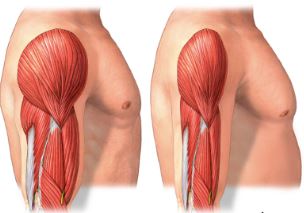Evaluation of Mamsa Dhatu in Mamsa Sara Purusha with special reference to Muscle Tone
DOI:
https://doi.org/10.21760/jaims.10.9.13Keywords:
Mamsa Dhatu, Mamsa Sara, Muscle Tone, Sara Pariksha, Muscle Strength, Manual Muscle TestingAbstract
Mamsa Dhatu, the third of the Sapta Dhatus in Ayurveda, plays a vital role in maintaining physical strength, stability, and vitality. Following the sequential transformation from Rasa and Rakta Dhatu, Mamsa Dhatu forms through the action of Mamsa Dhatvagni and contributes to covering, protecting, and supporting the body’s internal structures. The concept of Mamsa Saara Purusha - an individual endowed with superior muscle tissue - reflects excellence in both structural and functional aspects, such as compact musculature, strength, courage, and physical endurance. In modern physiological terms, muscle tone refers to the continuous and passive partial contraction of muscles, essential for maintaining posture, joint stability, and neuromuscular readiness. Evaluating muscle tone in individuals with Mamsa Saara reveals an intrinsic connection between Ayurvedic Dhatu quality and biomedical markers of health. These individuals typically exhibit optimal muscle tone, superior healing potential, and physical resilience, signifying a well-nourished Mamsa Dhatu in both quantity and quality. The article explores the classical definitions, properties, and functions of Mamsa Dhatu, its physiological formation, and the diagnostic relevance of Mamsa Sara Pariksha. It emphasizes the importance of maintaining dhatu balance through proper diet, lifestyle, and exercise. Furthermore, the integration of Ayurvedic principles with modern neuromuscular physiology offers a holistic approach to health assessment. Understanding Mamsa Saara Purusha through this dual lens not only validates ancient wisdom but also provides practical insights into sustaining muscular health and overall well-being.
Downloads
References
Acharya YT, editor. Charaka Samhita of Agnivesha. Vimana Sthana, Chapter 8, Verse 105. Reprint ed. Varanasi: Chaukhamba Surbharati Prakashan; 2014. p. 710.
Campbell WW, Barohn RJ. DeJong’s The Neurologic Examination. 7th ed. Philadelphia (PA): Lippincott Williams & Wilkins; 2019. Muscle tone; p. 467–74.
Taranatha Tarkavachaspati. Vachaspatyam [Sanskrit Dictionary]. Vol. 6. Varanasi: Chaukhambha Sanskrit Series; 1970. p. 4746.
Kotur P, Kotur S. A Textbook of Ayurvedic Physiology (Sharira Kriya Vignana). 1st ed. Dharwad: Vidyanidhi Prakashana; 2016. p. 228.
Monier-Williams M. Sanskrit-English Dictionary. Reprint ed. Delhi: Parimal Publications; 2011. p. 1185.
Amarasimha. Amarakosha (Namasangraha). With commentary of Bhanuji Diksita. 3rd ed. Varanasi: Chaukhambha Sanskrit Bhawan; 2009. p. 50.
Acharya YT, editor. Charaka Samhita of Agnivesha. Vimana Sthana, Chapter 5, Verse 8. Reprint ed. Varanasi: Chaukhamba Surbharati Prakashan; 2014. p. 680.
Acharya JT, editor. Sushruta Samhita. Sharira Sthana, Chapter 9, Verse 17. Varanasi: Chaukhamba Sanskrit Sansthan; 2012.
Acharya JT, editor. Sushruta Samhita. Sharira Sthana, Chapter 4, Verse 8. Varanasi: Chaukhamba Sanskrit Sansthan; 2012.
Acharya JT, editor. Sushruta Samhita. Sharira Sthana, Chapter 15, Verse 1. Varanasi: Chaukhamba Sanskrit Sansthan; 2012.
Acharya YT, editor. Charaka Samhita of Agnivesha. Chikitsa Sthana, Chapter 15, Verse 15. Reprint ed. Varanasi: Chaukhamba Surbharati Prakashan; 2014.
Acharya YT, editor. Charaka Samhita of Agnivesha. Chikitsa Sthana, Chapter 15, Verse 29. Reprint ed. Varanasi: Chaukhamba Surbharati Prakashan; 2014.
Acharya YT, editor. Charaka Samhita of Agnivesha. Vimana Sthana, Chapter 8, Verse 105. Reprint ed. Varanasi: Chaukhamba Surbharati Prakashan; 2014. p. 710.
Guyton AC, Hall JE. Textbook of Medical Physiology. 13th ed. Philadelphia: Elsevier; 2015. p. 428–33.
Kendall FP, McCreary EK, Provance PG. Muscles: Testing and Function with Posture and Pain. 5th ed. Philadelphia: Lippincott Williams & Wilkins; 2005.
Bohannon RW. Manual muscle testing: does it meet the standards of an adequate screening test? Clin Rehabil. 2005;19(6):662–7.

Published
How to Cite
Issue
Section
License
Copyright (c) 2025 Rohit H.E., Rakesh H.R., Rashmi N.M.

This work is licensed under a Creative Commons Attribution 4.0 International License.














